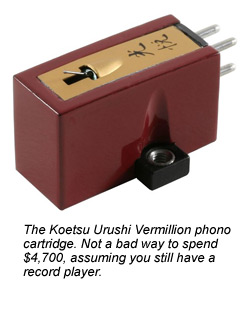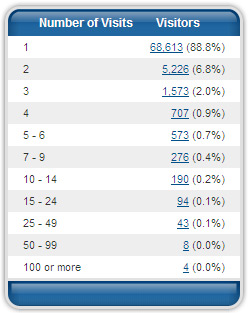I have been thinking a lot about numbers lately. Probabilities, assumptions, expectations, performance, segments, success, failure, improvement, and so many of the other things that we can use numbers for.
One project I am working on right now is to create a model for a weekly web analytics report for editors. With the help of folks around my company, we are identifying what metrics to focus on, what the reports should look like, how to pull them, how to communicate them, but most importantly, how to USE these reports to make proactive strategic decisions about online editorial.
The goals are simple:
- Identify simple ways to improve what we do with our existing resources.
- Make readers and customers smile.
In the meantime, I want to talk about the concept of 10%. This is something I have been thinking about for quite some time, and wanted to explore it a bit here. Three examples of why 10% can be important to you and your business:
- The Final 10% of a Goal Takes as Much Effort as the First 90%.
- Your Biggest Fans – Leveraging the Top 10% of Your Audience.
- Focusing Your Efforts on the Most Important 10% of Your Tasks, But Doing Them Exceptionally Well.
Is 10% the correct percentage to look at? Who knows – perhaps it is 13% or 35% in some cases. But I go into this with the assumption that if people are working really hard on something, doing the job of 3 people, putting in the hours, and have honed their skillset for years and years – that in all likelihood – they are doing an OUTSTANDING job; and yet, there is always room for improvement. That is the final 10% I am talking about.
When you look at products or services or people or companies or movements that simply WOW you, it is likely that they found a way to put in that extra 10% to get closer to perfection. You could even argue that it is impossible to achieve 100%, all you can hope to do is eek closer to it in ever smaller increments. That going from 96% to 96.8% takes millions of dollars and thousands of person-hours to achieve. For instance, it’s easy to make a car that gets 30 miles per gallon on a tank of gas. It’s harder to make one that gets 40 mpg, and takes an extreme effort – years of research to come up with that car that gets 50 mpg. 60 mpg. That’s another story entirely.
Or… why is that "perfect" diamond so much more expensive than the "average" diamond, even if it is the same size?
So let’s take apart what all this means, and how it might be helpful to you.
- The Final 10% of a Goal Takes as Much Effort as the First 90%.
You could go into a store, spend $10,000 on a stereo system, and still only end up with 80% of the listening experience that is possible in a home stereo. You see, I have this obsession with music and my stereo. Ask my wife about it, she will likely roll her eyes and just change the topic, bored of the whole thing. But I want to share something with you: This is the Koetsu Urushi Vermillion cartridge for a turntable. This is the "needle" for your records. Many audiophiles, myself included, feel that records still give you better sound than any form of digital music. And this little tiny thing retails for $4,700.
This is the Koetsu Urushi Vermillion cartridge for a turntable. This is the "needle" for your records. Many audiophiles, myself included, feel that records still give you better sound than any form of digital music. And this little tiny thing retails for $4,700.It should be noted that this is the "mid-priced" cartridge in their lineup that starts at $1,800 and goes right up to $20,000. (Check them out here.)
What does that $4,700 cartridge deliver that a $3,000 or $1,000 or $500 or $50 cartridge couldn’t? Likely, just a mere 10% or 5% or 2% or .5% increase in performance. Audiophiles will spend insane amounts of money for that final 10%. They want to experience perfection – or something close to it.
Most hobbies have products like this – and people who measure these tiny increments at the very high end of what is possible. For my wife, it is her art supplies… the brushes, paint, sketchbooks, etc. Of course, it’s also the thousands of hours she spends in her studio drawing and painting, and the hundreds of hours she spends reading and researching. (I am in awe of her, by the way.)
So how do we think about this in terms of online publishing? If anything, the challenge is merely this: accepting the fact that there is room for improvement, and that this fact does not at all diminish the value of what you are already achieving.
The biggest roadblock to finding greater success is often attitude. An attitude that perhaps one is already stretched too far, that it is impossible to do things better than they are currently done, or that simply, no one is asking for improvement – that if customers aren’t complaining, then they must be happy.
As I look at web metrics to understand how readers and customers use websites – as I talk to editors about their challenges and successes, I always keep in mind the Koetsu cartridges, and ask myself, how can we make things 1% better, and how can we find the process to do so without working weekends. This is not about creating misery – it is about finding joy.
Not easy, for sure. I’ve heard this expression before, and always liked it: "If you’re not going to do something right, why do it at all?" What inspires me are those people who are so passionate about their work, that they take it to the next level beyond doing something just "right," and aspiring to do it "great."
- Your Biggest Fans – Leveraging the Top 10% of Your Audience.
I have been working with many brands within RBI to help establish bloggers over the past 2+ years. There has been a lot of success in this area, but not every brand ends up with a superstar blogger. Recently, I have been chatting with editors who have 8 blogs that each get a mediocre amount of traffic, to see if focusing efforts on a single blog and shutting down the other 7 would be an option. The theory is this: If you have 3 editors working on three blogs, and 5 external contributors working on each of their own blogs, and they are all individually struggling to capture much of your audiences’ attention, then imagine what you could do if:
The theory is this: If you have 3 editors working on three blogs, and 5 external contributors working on each of their own blogs, and they are all individually struggling to capture much of your audiences’ attention, then imagine what you could do if:- You chose a single topic that keeps your readers up at night, and created a blog about it.
- Recruited an external contributor to act as "lead blogger" for this single blog. This is the "face" of the blog – the person who updates it at least a few times a week.
- Recruited 2 more external contributors to add to this blog, perhaps adding a single post a week each.
- Assigned one editor to "edit" the blog: work with the external contributor to come up with content ideas, feed them research, find images, market the blog to your audience and elsewhere on the web.
- Assigned another staff member as an editorial assistant to this blog – pulling metrics every week to see what is working, scouting out guest bloggers who can add a post here and there, etc.
So now you have 5 people working to make a single blog exceptional. A key ingredient here is to WOW your audience – to get them to see blogs as not just another content area that is "nice to have," but something incredible – that offers a real point of view in an area that can help their business and careers.
Let’s look at another example. If you go into a web analytics tool, you can find out Visitor Frequency – how many of your readers came to your website once during a given time period, or twice, or three times, etc. See the chart above.
What if you just focused on the top 10% of your readers here – the folks who come back to you 2 times a week or more? Then began tracking their metrics separately – how they got to your articles, what they read, how often, etc. What if you targeted your efforts to not just increase the size of your audience via tools like SEO, but increase the engagement of your core readers by understanding them better, and working to increase how often they come to your site, and how deeply they are involved with it?
- Focusing Your Efforts on just 10% of Your Tasks, But Doing Them Exceptionally Well.
By now you are likely seeing a common theme emerge. I spoke with an Editor-in-Chief this week about how to find time for projects and processes that increased online performance when his staff is already stretched to the hilt. Our conclusion was that this is where web metrics enter the picture. More likely than not, some of their efforts are wildly more beneficial to their audience than others. Perhaps eliminating the bottom 10% of what they do, and reallocating those resources to beefing up the top 10% was the way to go.Either way – it was obvious that a close look is needed at better understanding readers, their behavior, and their relationship to what we are doing. This is not to be critical of any existing process or content area – but to simply find the room for improvement that we know is there.
Well, if you made it this far into the article, I salute you, and I hope it was worth your time. I have to say, I am truly excited about the opportunities that lay ahead for online publishers.
